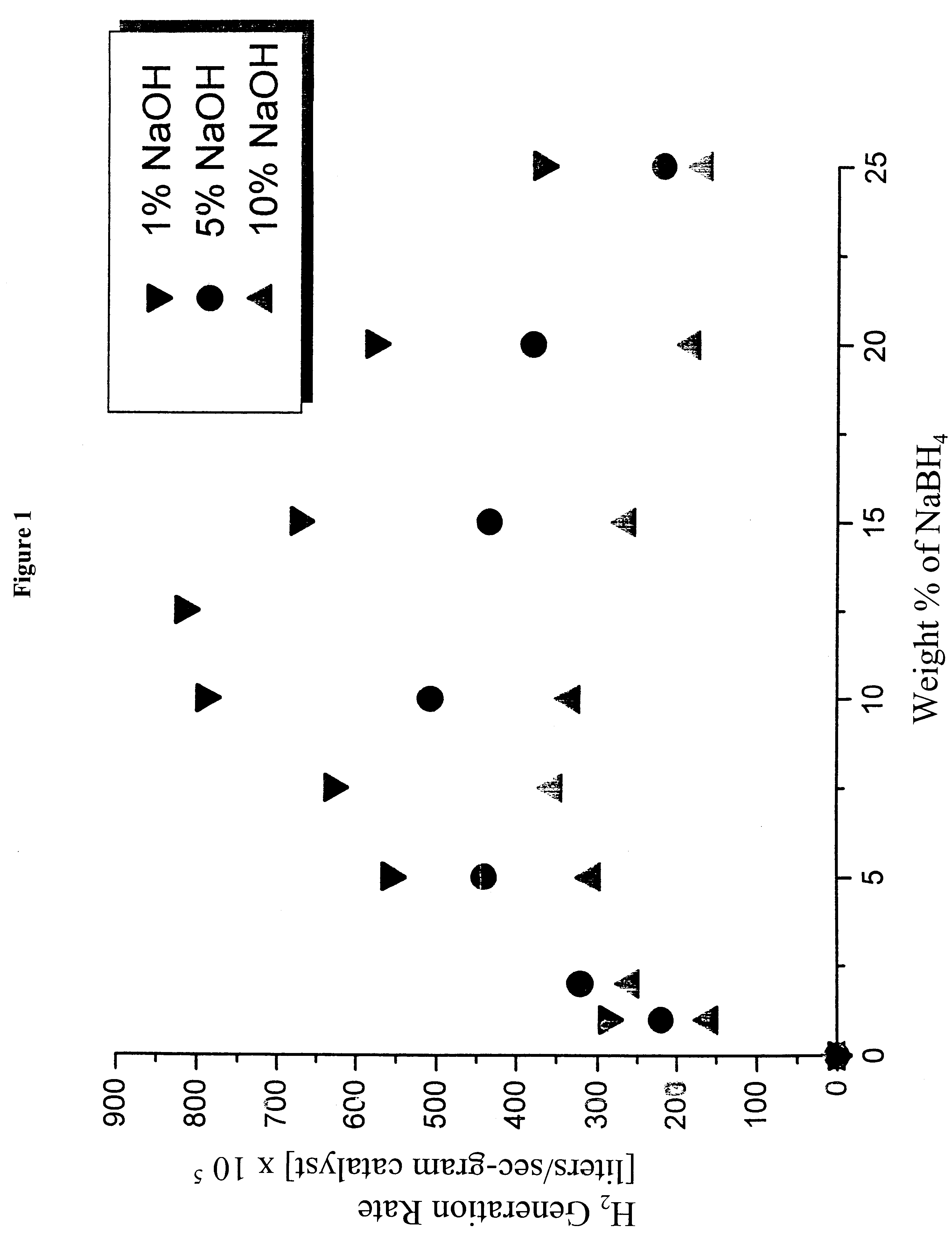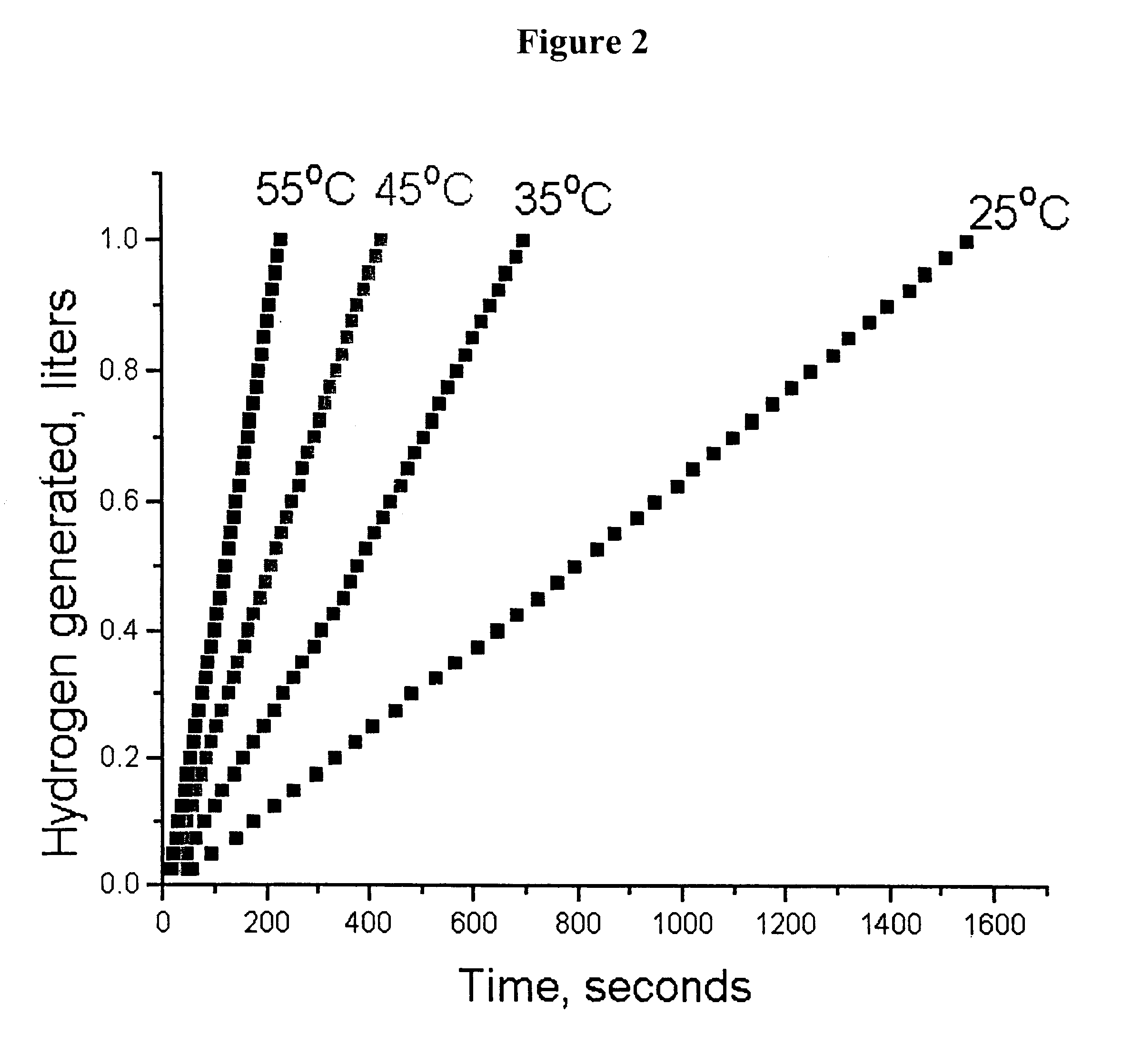System for hydrogen generation
a hydrogen generation and hydrogen technology, applied in the field of hydrogen generation systems, can solve the problems of insufficient or inpractical hydrogen storage methods for wide-spread consumer applications, volume density of 70 grams of hydrogen per liter, and clear insufficient for consumer applications
- Summary
- Abstract
- Description
- Claims
- Application Information
AI Technical Summary
Benefits of technology
Problems solved by technology
Method used
Image
Examples
example 1
to produce Rohm & Haas IRA-400 anionic exchange resin beads loaded with 5% by weight of ruthenium, platinum, and cobalt, respectively. The four different anionic exchange resin catalysts (i.e., ruthenium, rhodium, platinum, and cobalt) were tested for hydrogen generation. The results are illustrated in FIG. 7, which shows a plot of hydrogen volume (liters) vs. time (seconds) for the reaction of 0.25 grams of 5% by weight loading on Rohm & Haas IRA-400 anionic resin beads of each respective catalyst with a stabilized metal hydride solution containing 20% by weight of sodium borohydride, 10% by weight of sodium hydroxide, and 70% by weight water. As can be seen from FIG. 7, the anionic exchange resins with ruthenium provided the best hydrogen generations rates with the rest of the catalysts performing in the following order: rhodium>platinum>cobalt.
example 2
Preparation of Catalysts Systems with Ceramic and / or Carbon Substrates
Zirconium dioxide, ZrO.sub.2, 8 mesh chips from Alfa-Aesar, located in Massachusetts, were soaked in a solution of ruthenium trichloride at a concentration of about 5% by weight. Without wanting to be limited by any one theory, it is believed that the ruthenium trichloride was absorbed by the porous zirconium dioxide bead. The beads were then filtered but not rinsed, and placed in a drying oven at 110.degree. C. until dry. The ruthenium trichloride absorbed onto and / or within the beads were then reduced with a solution including 20% by weight of sodium borohydride, 10% by weight of sodium hydroxide, and 70% by weight of water. The beads were heated in the solution for about 30 minutes at 65.degree. C. After rinsing with water, the beads were ready for use in the hydrogen systems of the present invention. Almost all other porous substrates, such as ceramic and carbon substrates, can be converted in a similar manner...
example 3
Preparation of Catalyst Systems with Cationic Exchange Resin Substrates
As described earlier with cationic resins, ruthenium trichloride was reacted with silver perchlorate solution in a 1:3 molar ratio of Ru:Ag to obtain 0.5 grams of elemental ruthenium. Precipitation of silver chloride was observed. After filtering out the precipitate, sodium hydroxide was dropwise added to the remaining solution of ruthenium perchlorate to adjust the pH to about 7. A vertical column was packed with 10 grams of Rohm & Haas IRA-120 cation exchange resin beads. The ruthenium perchlorate solution was repeatedly poured down the column until the solution no longer had a reddish color, thereby obtaining cationic exchange beads with 5% by weight of ruthenium (0.5 grams of ruthenium for 10 grams of resin beads). After exchanging the ruthenium onto and / or into the beads, they were rinsed with deionized water and reacted with a solution of sodium borohydride as the reducing agent. The dark red resin beads tu...
PUM
| Property | Measurement | Unit |
|---|---|---|
| pH | aaaaa | aaaaa |
| pressures | aaaaa | aaaaa |
| total weight | aaaaa | aaaaa |
Abstract
Description
Claims
Application Information
 Login to View More
Login to View More - R&D
- Intellectual Property
- Life Sciences
- Materials
- Tech Scout
- Unparalleled Data Quality
- Higher Quality Content
- 60% Fewer Hallucinations
Browse by: Latest US Patents, China's latest patents, Technical Efficacy Thesaurus, Application Domain, Technology Topic, Popular Technical Reports.
© 2025 PatSnap. All rights reserved.Legal|Privacy policy|Modern Slavery Act Transparency Statement|Sitemap|About US| Contact US: help@patsnap.com



